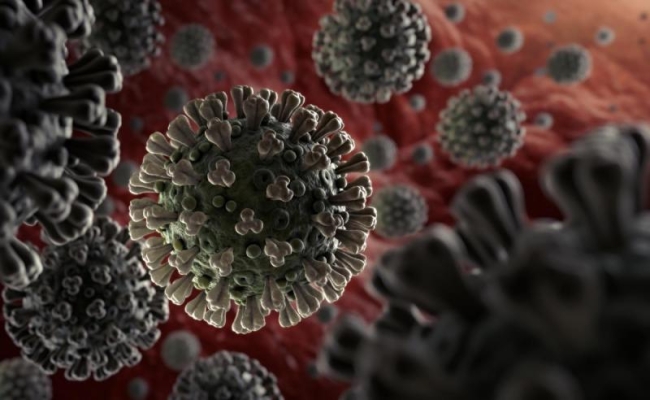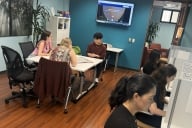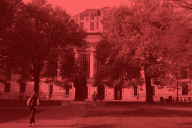You have /5 articles left.
Sign up for a free account or log in.

ISTOCK.COM/FPM
There's a lot going on in the world right, a lot that is much larger than higher education.
Inside Higher Ed is not your source for all news, so I hope you are reading other outlets to understand what's happening beyond the coronavirus pandemic and what colleges are up to.
With that said, I can provide some palate cleansers to serve as a reprieve from the dark and angering for a moment.
The New York Times has a nice story on bird watching, which I think could serve as a kind of meditation to calm your nerves.
Keeping on the bird theme, this is not necessarily a happy story, but it is interesting: as eagles make a comeback in New England, apparently other birds are fighting them.
Here's a hot take on why grilling is stupid when many people have ovens in cooler, indoor spaces.
Make sure to read until the end of the roundup for today's Q&A. It features the president of the Institute for Higher Education Policy talking about the group's new report.
On to the news.
A group of Senate Democrats is asking U.S. Secretary of Education Betsy DeVos to call on the Education Department to remedy an error by Great Lakes Educational Loan Services. The loan servicing company reportedly provided incorrect payment information for millions of federal student loan borrowers to credit reporting agencies, which likely lowered borrowers' credit scores.
Senator Patty Murray, the top Democrat on the Senate's education committee, opposes shielding colleges from liability lawsuits related to COVID-19 should campuses reopen.
Medical experts for the National Collegiate Athletic Association released specific recommendations Friday for member institutions to consider as college athletes return to campus facilities and are permitted to begin training. They recommend that colleges evaluate athletes for COVID-19 exposure before they return to campus facilities and consider asking athletes and staff to screen themselves for symptoms daily.
Here’s a quick roundup of our latest stories, in case you’ve fallen a bit behind (we don’t blame you):
Lilah Burke has a story on the increasing concerns for the next academic year, and how many high school seniors are considering delaying their enrollment.
Some advocates are worried that the Trump administration is planning to restrict a program that lets international students work in the U.S. for up to three years after graduating from college, Elizabeth Redden reports.
Elizabeth also has a story on the administration's reported plans to cancel the visas of Chinese graduate students and researchers who attended universities with ties to the People's Liberation Army.
I wrote about a nonprofit's plans to buy the Marlboro College campus and create an innovative late high school/early college program.
News From Elsewhere
NPR dived into the lawsuits many elite institutions are facing after switching to remote learning for the spring semester.
MarketWatch evaluated the value of college degrees.
Closed campuses could complicate Joe Biden's outreach plans for young voters, The Wall Street Journal reports.
Percolating Thoughts
This is a time when everyone has an opinion. As journalists, we try not to have opinions, but we've gathered some interesting ones from others.
The CEO of the Jed Foundation wrote about how institutions can promote and support mental health for students during the pandemic.
Several people from campuses within the City University of New York system wrote in the Daily News about the need to invest in the colleges to ensure equity for the city's students.
Thanks for sticking around for our Q&A. I talked with Michelle Asha Cooper from the Institute for Higher Education Policy in D.C. about their new joint report with the Southeast Asia Resource Action Center. It explores how student data for subgroups within the Asian American and Pacific Islander communities aren't disaggregated, and why that's an issue. 
Q: Why does the U.S. Department of Education not disaggregate these data?
A: Well, unfortunately, that is not an answer that I know. I know that it can do more. One of the recommendations that we put forth in this brief is that the U.S. Department of Education should revise the guidance that it put out in 2007 around maintaining, collecting and reporting racial and ethnic identity data, and require institutions to report disaggregated data on AAPI students that is consistent with how the U.S. Census Bureau reports this disaggregated data.
Right now the Census Bureau recognizes at least 25 distinct self-identified AAPI groups. Now, I want to be clear, there’s certainly more than 25 of them, but that is a step in a positive direction, recognizing that the Census Bureau is looking at 25 distinct groups. We believe that if the Department of Education were to go in a similar direction, that would allow us to really be able to speak with more authority and credibility around the issues and opportunities for better serving Asian and Pacific Islander students.
Q: Can you talk about the harm not disaggregating data can do?
A: One thing I truly believe is that when we don’t see things, we can’t speak to them. When individuals are invisible to us in the data, they also remain invisible in policy conversations and they remain invisible in terms of institutional improvements that can help around things that practitioners do. We really want to get a better handle on, how is the AAPI community faring within higher education? What are the distinct challenges that they are facing? And we do believe that If we are able to better disaggregate the data along racial and ethnic lines, we would be able to answer those questions better.
Q: Is it difficult to disaggregate the data?
A: I'm not really sure why people aren’t doing it. There's certainly ways that we could speculate on that.
But If we’re collecting the data and we’re asking the right questions, where we’re asking people to self-identify along these particular groups, then we really would be able to disaggregate the data in the most appropriate way. Right now we are not asking the relevant questions in order to get the answers that are most appropriate.
Sometimes, I think, when it comes to the AAPI community, it has historically been a small community, so people may not have been focused on it the way that they should have been. Right now, the Asian American/Pacific Islander community is one of the fastest growing in the nation among all racial groups. They are growing significantly. To not count them and not be looking at the variations in cultural, linguistic and racial and ethnic identity that we know these individuals themselves self-identify as, is doing a real disservice to them.
Q: Can you talk about how this population is growing?
A: I believe that over the last, say, decade, we saw that the Asian American population grew by 28 percent. The Native Hawaiian/Pacific Islander population grew by 19 percent. That's pretty significant growth.
[Editor's note: Data from the Western Interstate Commission for Higher Education show that the number of high school graduates who identify as Asian American or Pacific Islander is expected to increase by 101 percent between 2001 and 2032.]
If we would gather detailed race and ethnicity data, policy makers and institutional leaders would be in a better position to properly identify the students who are on their campuses and improve services and programs that address their needs. Right now we have lived under this sort of myth around the model minority in Asian communities.
First of all, it’s a myth. Second of all, it has brought a lot of disservice to many subgroups within the Asian community because they get overlooked for the services that they need. When we overlook people, we are masking the inequities that they are up against and we are also sometimes inadvertently perpetuating them. This is something that in postsecondary education we have the means to stop.
One of the ways we can start reversing that trend is by really making sure we are counting these students in our data collection. That we’re looking at who they are and we’re looking at patterns that would support strong outcomes for all of the subgroups.
Q: Can you discuss the idea of the model minority?
A: It’s important to really address the elephant in the room. And that elephant in the room is often, when we’re talking about Asian students, the model minority myth. If you trace the origins of where the myth came from, the myth itself has racialized underpinnings.
It was created in a time in the mid-1960s to pit racial groups against each other. In this particular instance, it was the Asian Americans against African Americans. It was trying to lift up one group as model and one group as not. That alone is damaging to so many things in our society.
When we continue to perpetuate this myth, it then does not allow us to really look at how are we serving the Asian student population. What many of us know who have been working in higher education, and we've been working with institutions that have actually started to disaggregate their data, is that there are many different subgroups within the Asian population. When we don’t look at these subgroups and we only focus on the broad category, it is concealing, it is hiding those differences and those inequities that are within that AAPI student group.
It is hampering policy makers' and institutional leaders’ ability to take on evidence-based action and evidence-based change. Our current data collection and reporting policies perpetuate this myth of a model minority because they do not really go deep enough. It does not allow itself to go deep enough to really look how we are serving Asian students and whether or not they really do need the assistance that other institutions have already shown that they need.
The myth diminishes the diversity that exists within the AAPI community. And it overaggregates the experiences of some Asian populations by masking the inequities which others in that group are facing.
Q: Can you talk about some of the examples of how masking this data hurts some populations? The report mentions issues like how certain Asian populations have traumatic histories of war, genocide and displacement, which can affect their social mobility.
A: It's certainly all of those examples. But it’s really, whenever we fail to not see people or see their stories, and their stories have linkages to their identity and their own cultural and historic backgrounds, then we fail to be able to really show up for them and to support them. There are a number of instances where this has been true for Asian American/Pacific Islander students.
Now is a time when we are all in this COVID-19 experience where many are suffering, many are struggling, and it’s a moment when we can really lift the veil on so many inequities that have plagued our society and had ripple effects on our postsecondary education systems, and do something different and do something better.
One of the things that we at IHEP see that could lend itself to doing something better is just making sure that all students count. Making sure that they count would help make sure that they matter, and that we can really look at the outcomes and the services that are going to really target them and put them on the path toward graduation, college completion and social and economic mobility. That is the way that we help serve students. That's the way that we would help improve the AAPI community as whole. And that is the way that we ensure that we are strengthening all of the underpinnings of our society.
Q: What does the report recommend people do to fix this issue?
A: In our recommendations, we wanted to make sure that we were, one, raising awareness about the challenges of being an invisible population. But we also wanted to help people recognize that there were things that could be done.
There are things that can be done on the legislative level. There are also things that can be done within the Department of Education, and also things that can be done at the institutional levels.
Legislatively, we believe that Congress can create a federal mandate that ensures consistency in how data are disaggregated and reported across the board. That would really make sure that all government agencies and postsecondary institutions are disaggregating AAPI data in ways that make sure that students are represented in policy and programmatic decisions.
At the Department of Education, it’s really about making sure that they revise their guidance on how we maintain, collect and report racial and ethnic data, to require postsecondary institutions to report AAPI data.
The third thing is really around looking at institutions and making sure that they are doing more to disaggregate AAPI data in their own institutional data collection policies.
Q: Is there anything else you’d like to say about this issue or the report?
A: The main thing is really that we are at a time when we can do better and we should be doing better. It's a time when we know that our actions have not been favorable in terms of supporting AAPI students.
This is an easy fix, this is an easy way to be more inclusive, this is an easy way to support and target more students. All it requires is that we look at our data collection policies and do what the Census Bureau is already doing. We know it can be done.
Have any percolating thoughts or notice any from others? Feel free to send them our way or comment below.
We’ll continue bringing you the news you need in this crazy time. Keep sending us your questions and story ideas. We’ll get through this together.








